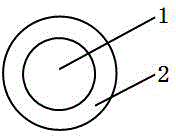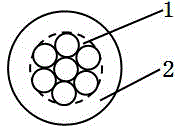Anti-termite cable material and cable using same
An anti-ant cable and raw material technology, applied to insulated cables, cables, circuits, etc., can solve the problems of difficulty in controlling the thickness of nylon layer, yellowing of nylon 12 pole layer, and high price of nylon 12, and achieve low gas permeability. , the effect of viscosity increase, excellent electrical insulation properties
- Summary
- Abstract
- Description
- Claims
- Application Information
AI Technical Summary
Problems solved by technology
Method used
Image
Examples
Embodiment 1
[0027] An anti-termite cable material is characterized in that it contains the following raw materials in parts by weight: 30 parts of ethylene-tetrafluoroethylene copolymer, 30 parts of propylene-tetrafluoroethylene copolymer, 12 parts of glass fiber, 2 parts of magnesium hydroxide 2 parts, 2 parts of mica powder, 2 parts of carbon black or titanium dioxide, 1 part of bifenthrin, 3 parts of toluene.
[0028] The above-mentioned anti-termite cable material is prepared by the following method: first weigh ethylene-tetrafluoroethylene copolymer, propylene-tetrafluoroethylene copolymer, glass fiber, magnesium hydroxide, mica powder, Carbon black or titanium dioxide, bifenthrin, toluene; then mix ethylene-tetrafluoroethylene copolymer and propylene-tetrafluoroethylene copolymer and stir evenly while heating to 280-320°C, and keep warm for 2-4 hours Stop heating; then add glass fiber, magnesium hydroxide, mica powder, carbon black or titanium dioxide, stir evenly, and control the t...
Embodiment 2
[0030] An anti-termite cable material is characterized in that it contains the following raw materials in parts by weight: 35 parts of ethylene-tetrafluoroethylene copolymer, 35 parts of propylene-tetrafluoroethylene copolymer, 15 parts of glass fiber, 3 parts of magnesium hydroxide 3 parts, 3 parts of mica powder, 3 parts of carbon black or titanium dioxide, 2 parts of bifenthrin, 4 parts of toluene; The preparation method of this implementation example is the same as the first implementation example.
Embodiment 3
[0032]An anti-termite cable material is characterized in that it contains the following raw materials in parts by weight: 40 parts of ethylene-tetrafluoroethylene copolymer, 40 parts of propylene-tetrafluoroethylene copolymer, 18 parts of glass fiber, 4 parts of magnesium hydroxide 4 parts, 4 parts of mica powder, 4 parts of carbon black or titanium dioxide, 3 parts of bifenthrin, 5 parts of toluene; The preparation method of this implementation example is the same as the first implementation example.
PUM
| Property | Measurement | Unit |
|---|---|---|
| Tensile strength | aaaaa | aaaaa |
| Tensile strength | aaaaa | aaaaa |
| Fineness | aaaaa | aaaaa |
Abstract
Description
Claims
Application Information
 Login to View More
Login to View More - R&D
- Intellectual Property
- Life Sciences
- Materials
- Tech Scout
- Unparalleled Data Quality
- Higher Quality Content
- 60% Fewer Hallucinations
Browse by: Latest US Patents, China's latest patents, Technical Efficacy Thesaurus, Application Domain, Technology Topic, Popular Technical Reports.
© 2025 PatSnap. All rights reserved.Legal|Privacy policy|Modern Slavery Act Transparency Statement|Sitemap|About US| Contact US: help@patsnap.com



